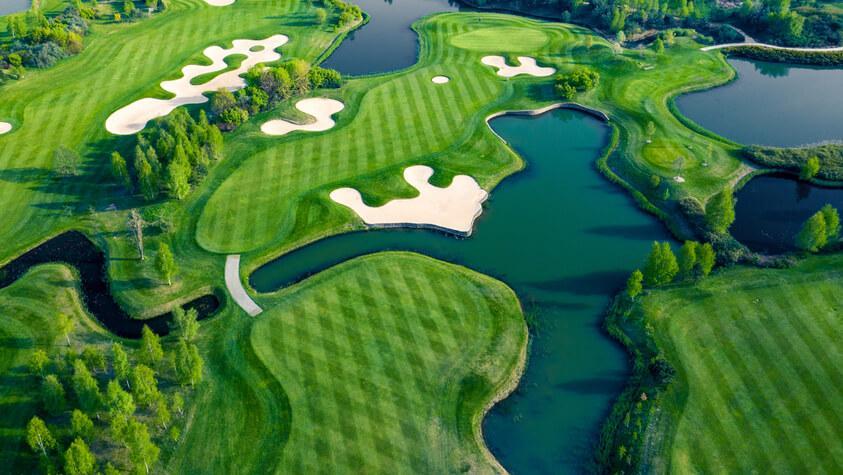Strategic Golf Course Design: Enhancing Gameplay and Experience
The world of golf intricately weaves together precision, strategy, and artistry in course design. This article embarks on a scholarly journey into “Strategic Golf Course Design: Elevating Challenge and Enjoyment,” revealing how thoughtful planning transforms ordinary landscapes into captivating arenas for golfers. With a focus on the interplay between accessibility and excitement, we explore how effective design can create an enriching experience for players of all skill levels.
Core Components of Effective Golf Course Design
Creating Engaging Challenges with Thoughtful Hole Designs
A successful golf course is not just visually appealing; it is meticulously crafted to present challenges that engage players at every hole. The layout of each hole serves as the foundation for a stimulating golfing experience, blending complexity with enjoyment.
Designers strive to offer varied playing experiences that challenge golfers’ skills while encouraging strategic decision-making. Each hole becomes a unique puzzle requiring careful planning from tee to green.
The strategic placement of hazards—such as bunkers or water features—adds depth to the gameplay by compelling players to weigh risks against rewards, enhancing tactical considerations for every shot taken.
Engaging Players through Innovative Bunkering Techniques
Enhancing Playability with Strategic Green Complexes
The design of green complexes plays a pivotal role in elevating the overall golfing experience. The positioning and contouring of greens can significantly affect both challenge levels and player satisfaction across various skill sets. By placing greens thoughtfully in relation to hazards, designers create dynamic environments that require precision on every stroke.
A key feature in this aspect is incorporating undulations within putting surfaces that test golfers’ abilities while introducing an element of unpredictability—keeping them engaged throughout their rounds. Greens designed to reward skilled putting while penalizing mistakes foster satisfaction among players, making each hole memorable.
Additionally, varying distances between tees and greens influences gameplay flow by presenting diverse shot scenarios that necessitate adaptive strategies from golfers regarding club selection—a deliberate orchestration enhancing both depth and enjoyment during play.
Sustainability Meets Accessibility in Modern Golf Course Design
Sustainable Practices in Course Architecture
A well-designed golf course harmonizes aesthetics with environmental responsibility. By integrating sustainable practices into their layouts—like eco-friendly turf management techniques—architects can minimize ecological footprints while providing enjoyable golfing experiences.
Pillars of Accessibility Enhancement
Merging challenge with accessibility ensures inclusivity across all player demographics. Designers must carefully consider tee placements alongside hazard locations so both seasoned veterans and newcomers find engaging options available during playtime.
Clear navigation aids further enhance inclusivity within courses catering towards diverse audiences seeking enjoyable rounds without compromising difficulty levels!
Cultivating Memorable Experiences through Thoughtful Planning
The artful blend between creativity & science defines successful golf course designs aimed at optimizing player engagement via captivating layouts & interactive features! Emphasizing sustainability alongside accessibility allows architects not only deliver challenging yet rewarding experiences but also immerse participants fully within nature’s beauty throughout their journeys!
Conclusion: Insights into Strategic Golf Course Architecture
The intricate craft behind strategic golf course design remains essential for achieving excellence within this beloved sport! By considering elements such as hole configurations along with bunker placements & green complexities; designers cultivate environments offering balanced challenges tailored specifically towards maximizing enjoyment experienced by all types—from novices up through professionals alike! Striking harmony between difficulty levels whilst prioritizing sustainability encapsulates what truly defines exceptional architectural endeavors aimed at creating unforgettable rounds filled rich memories forged upon lush fairways!

Mastering the Art of Golf Course Design: Crafting a Perfect Blend of Challenge and Enjoyment
Meta Title
Mastering Golf Course Design: Create the Ideal Balance of Challenge and Fun
Meta Description
Discover the art of golf course design, including key elements that ensure both challenge and enjoyment for players. Explore practical tips and case studies to enhance gameplay.
Understanding the Fundamentals of Golf Course Design
Golf course design is a harmonious amalgamation of art and science. It requires a keen understanding of terrain, aesthetics, and player psychology. Key components contribute to crafting a course that both challenges and entertains golfers:
Key Elements of Golf Course Design
- Terrain Utilization: Understanding the landscape’s natural features can enhance playability.
- Hole Layout: Strategic arrangement of holes creates varying levels of difficulty and excitement.
- Bunkering: Properly placed bunkers serve as hazards that influence shot selection while enhancing aesthetics.
- Green Complexes: The design of greens can promote strategic play and challenge golfers of various skill levels.
Prioritizing Player Experience: The Psychographics of Golfers
A fundamental aspect of course design is understanding players’ motivations and expectations. Designers must consider:
- Skill Levels: Courses should offer multiple tee options to cater to beginners, intermediates, and advanced players.
- Play Speed: Design elements that encourage efficient play help maintain a steady pace on the course.
- Accessibility: Ensuring that the course is playable for individuals of varying abilities adds to its overall appeal.
Incorporating Environmental Sustainability
Sustainable practices in golf course design not only protect natural habitats but also enhance the golfing experience. Key considerations include:
- Water Management: Implementing efficient irrigation systems and drought-resistant landscaping can reduce water consumption.
- Native Planting: Utilizing local flora supports biodiversity and requires less maintenance.
- Wildlife Preservation: Designing courses to incorporate natural habitats can improve the ecological footprint.
The Role of Aesthetics in Golf Course Design
A visually appealing course enhances player satisfaction and retention. Elements to consider include:
- Scenic Views: Ensuring that fairways and greens frame breathtaking landscapes encourages enjoyment.
- Landscaping: Thoughtful planting and maintenance create a picturesque environment.
- Artistic Features: Fountains, bridges, and sculptures can add character and create memorable experiences.
The Challenge of Creating Memorable Holes
Memorable golf holes often incorporate distinctive characteristics and strategic elements. Effective designs include a mix of:
Hole Design Essentials
- Variety of Lengths: A blend of par 3, par 4, and par 5 holes keeps play exciting.
- Elevation Changes: Incorporating hills and valleys adds dynamic challenges and scenic beauty.
- Hazards: Well-placed water features and sand traps compel players to strategize their shots.
Case Studies: Iconic Golf Courses
Exploring renowned golf courses can provide insights into successful design elements. Here are a few examples:
| Golf Course | Location | Notable Features |
|————————-|——————–|———————————————————————————-|
| Augusta National Golf Club | Augusta, Georgia | Stunning aesthetics coupled with strategic hole designs that challenge golfers. |
| Pebble Beach Golf Links | Pebble Beach, California | Breathtaking coastal views and a mix of challenging holes that test all skill levels. |
| St. Andrews Links | Fife, Scotland | Historic layout that combines strategic design with natural terrain features. |
These courses exemplify how thoughtful design elements contribute to unforgettable golfing experiences.
Practical Tips for Aspiring Golf Course Designers
For those looking to design a golf course or improve an existing one, consider these practical tips:
Design Tips
- Conduct Player Surveys: Understanding player feedback can guide necessary adjustments and enhancements.
- Embrace Technology: Utilize software for accurate land surveys and 3D modeling, ensuring optimized layouts.
- Regular Maintenance: Invest in ongoing maintenance to uphold course quality and playability.
Creative Design Ideas
- Themed Holes: Create a unique identity for each hole, offering a variety of challenges and experiences.
- Integrated Technology: Consider app integrations for GPS, offering tips, and course layout for players.
The Evolution of Golf Course Design Trends
As golf continues to evolve, so does course design. Key trends shaping the future include:
- Flexible Course Layouts: Multipurpose courses that can accommodate different sports and activities.
- Minimalist Design: A move toward simpler, less manicured courses that prioritize playability over aesthetics.
- Technology Integration: Enhanced features such as smart cart systems and data analytics for performance tracking.
Conclusion
Golf course design is a multifaceted endeavor that blends creativity, strategy, and player psychology. By mastering the elements that contribute to both challenge and enjoyment, designers can create courses that resonate with golfers and stand the test of time.
Keywords
- Golf course design
- Golf gameplay
- Hole layout
- Bunkering
- Green complexes
- Environmental sustainability
- Player experience
- Aesthetic design
- Memorable holes
By incorporating these elements, the article can become a valuable resource for those seeking to enhance their understanding of golf course design while also optimizing for search engines.







